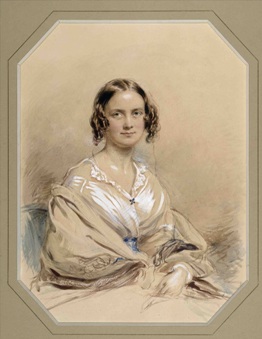Geologist and science writer Nina Morgan sympathises with the geological wives

The important intellectual role played by women in geology during the 19th Century is now increasingly celebrated. But often these achievements went unrecognised at the time. The credit given by the geologist and palaeontologist John Phillips (1800-1873) to his sister Anne in his 1848 Geological Survey Memoir on the Malverns, highlighting her discovery of a crucial piece of evidence about the origin of the Hills is a rare example of credit being given where it was due. More usually, the behind-the-scenes social and diplomatic skills of loyal wives, sisters and daughters in bringing together scientists and providing the favourable environment for discoveries to take place is hinted at only in posthumously published ‘Lives and Letters’, but not in scientific publications of the time.
In letters written on 29 March and 2 April 1839 to her sister Elizabeth Wedgwood, Emma Darwin (pictured), then just two months into her marriage to geologist and biologist Charles Darwin (1809-1882) reveals the difficulties of dealing with socially inept scientists, including geologists, Adam Sedgwick (1785-18730), Charles Lyell (1797-1875) and W H Fitton (1780-1858).
On 29 March 1839, she writes:
...On Thursday Mr Sedgwick called and was very pleasant; there is something remarkably fresh and odd about him. The Henslows [The Rev. John Stevens Henslow (1796-1861), botanist and geologist and Darwin's mentor at Cambridge, who encouraged Darwin to join the Beagle expedition] come on Monday, and Charles is much more alarmed at the thought of them than I am. On Monday the Lyells dine with us...
And on Tuesday 2 April 1839, she provides a full report of how it all went:
... I must tell you how our learned party went off yesterday. Mr and Mrs Henslow came at four o'clock and she, like a discreet woman, went up to her room till dinner. The rest of the company consisted of Mr and Mrs Lyell and Leonora Horner [Mrs Lyell's sister], Dr Fitton and [botanist] Mr Robert Brown (1773-1858). We had some time to wait before dinner for Dr Fitton, which is always awful, and, in my opinion, Mr Lyell is enough to flatten a party, as he never speaks above his breath, so that everybody keeps lowering their tone to his... Mr Brown, whom Humboldt calls "the glory of Great Britain," looks so shy, as if he longed to shrink into himself and disappear entirely; however notwithstanding those two dead weights, viz., the greatest botanist and the greatest geologist in Europe, we did very well and had no pauses. Mrs Henslow has a good, loud, sharp voice which was a great comfort, and Mrs Lyell has a very constant supply of talk ... Charles [Darwin] was dreadfully exhausted when it was over, and is only as well as can be expected today ... He is rather ashamed of himself for finding his dear friends such a burden."
But for her part, Emma seems to have taken the evening in her stride. The food, at least, she reveals was very good!
Acknowledgement
Sources for this vignette include: Emma Darwin A Century of Family Letters 1792-1896, edited by her daughter Henrietta Litchfield, John Murray, 1915; Anne Phillips and the Mystery of the Malverns by Nina Morgan, Geoscientist, Vol.16, No 7, July 2006, pp. 6 – 7 and 12-15; entries for John Henslow and Charles Lyell in Wikipedia and the Dictionary of National Biography.
- If the past is the key to your present interests, why not join the History of Geology Group (HOGG). For more information and to read the latest HOGG Newsletter, visit the HOGG website at: www.historyofgeologygroup.co.uk, where you'll also find abstracts for the talks and posters presented at the Conference on Geological Collectors and Collecting, April 2011 available free to download as a pdf file.
*Nina Morgan is a geologist and science writer based near Oxford.